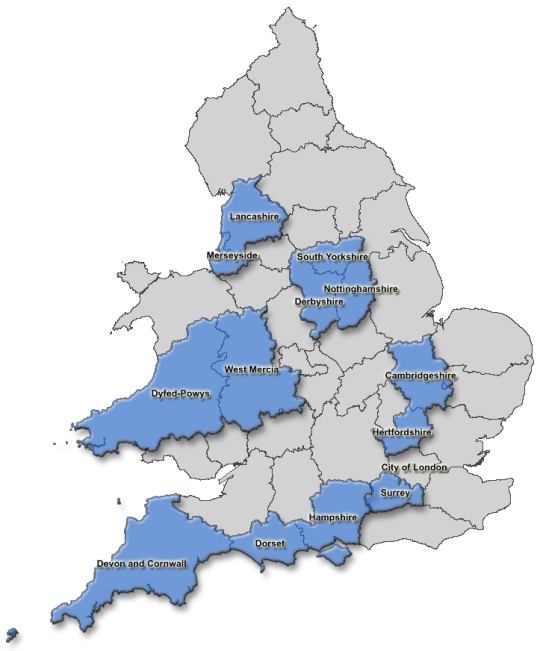
Post: 2 March 2017
Yesterday I was talking to a local journalist about spending data published by Police and Crime Commissioners (PCCs). You can read Alon Aviram’s article on the Bristol Cable website for the full context.
That discussion was about specific issues. However I thought I’d also have a quick trawl through the 40 or so PCC websites and see how their spending data stacks up generally from an open data perspective.
Like other parts of the public sector, PCCs have a statutory obligation to publish a range of transparency information. This includes all items of expenditure over £500, each month as soon as practicable after the end of the month to which it relates.
Unfortunately the regulations don’t say much about how PCCs should publish the information. Home Office guidelines expect PCCs to make the information available on the internet in an “easily accessible format”, but don’t cover matters of copyright or re-use.
There are 41 PCCs in England and Wales. London has slightly different arrangements but for completeness I also looked at the equivalent spending data for the Metropolitan and City of London policing authorities.
Availability and timeliness
All but one policing authority currently makes its spending data available on the web. Cumbria PCC’s website is “under construction” and the relevant page produces a 404 error.
A majority of PCCs have published spending data for December 2016 and/or January 2017, so are up to date. However others have fallen well behind.*
* Update 7 March 2017: This paragraph has been updated to remove specific references to Durham PCC and Essex PCC. Durham’s site has an old page with spend data up to 2015, but also a newer page with spend data up to January 2017. Similarly Essex’s site has spend data published in two places: a scrutiny page with transactions up to November 2015 and a finance page with transactions up to September 2016.
Data formats
Spending data is published in an open, accessible format on 14 PCC websites (including City of London), as shown on the map below. The others publish their data only in PDF.

Data in PDFs cannot be sorted or manipulated. Tabular data in PDFs is not compliant with the Open Definition unless it is also available in an accessible format such as CSV.
PDF-only publication is sometimes interpreted as a tactic to discourage re-use and scrutiny of public data.
Terms of re-use
None of the PCC spending data is currently available for re-use under a compliant open data licence. I was unable to find any relevant information about copyright or licensing on 24 of the sites. Most of the remaining sites have notices that permit personal or non-commercial re-use of content only.
Two PCCs ostensibly allow re-use of material on their websites under the Open Government Licence. However in both instances the OGL has been vitiated by additional terms. The PCC for Greater Manchester reserves the right to take away re-use rights if he feels his content is “misused in anyway”. The PCC for Warwickshire makes re-use of his material subject to it “being reproduced accurately and not being used in a misleading way”.
Why is there no open spending data from PCCs?
None of the spending data published by PCCs currently meets the minimum criteria for open data. Some PCCs are also clearly in breach of the statutory requirement to publish their spending data on a monthly basis.
Open data as a concept may not be well understood among PCCs. Home Office has not encouraged them to publish data under an open licence and the publication guidelines do not make clear that PDF is not an easily accessible format. One police force even says it has been “directed by the Government” to publish PCC spending data in PDF.
What can be done?
Ideally Home Office would implement additional requirements for good practice in publication of spending data and other transparency information by PCCs, either in regulations or in amended guidelines. These requirements should be similar to those in the Local Government Transparency Code, which says:
Public data should be published in a format and under a licence that allows open reuse, including for commercial and research activities, in order to maximise value to the public. The most recent Open Government Licence published by the National Archives should be used as the recommended standard.
Home Office and the Association of PCCs should monitor publication of transparency information by PCCs and remind them of their statutory obligations if they fall behind.
It might also be worthwhile for the Government Digital Service to distribute general guidance to contacts responsible for public sector websites, explaining the basic principle of “open by default” and the advantages of incorporating the Open Government Licence into site-level terms and conditions. Although open formats and open licensing are now reasonably well understood within central and local government, there is still work to be done to embed these practices in other parts of the public sector.
Map image attribution statement: contains Ordnance Survey data © Crown copyright and database right 2016 and contains National Statistics data © Crown copyright and database right 2016.
The above article is published under a Creative Commons Attribution licence (CC-BY 4.0). Attribution statement: © Owen Boswarva 2017.